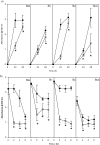Characterization of the poly-β-1,6-N-acetylglucosamine polysaccharide component of Burkholderia biofilms
- PMID: 21984237
- PMCID: PMC3233048
- DOI: 10.1128/AEM.05814-11
Characterization of the poly-β-1,6-N-acetylglucosamine polysaccharide component of Burkholderia biofilms
Abstract
We demonstrated the production of poly-β-1,6-N-acetylglucosamine (PNAG) polysaccharide in the biofilms of Burkholderia multivorans, Burkholderia vietnamiensis, Burkholderia ambifaria, Burkholderia cepacia, and Burkholderia cenocepacia using an immunoblot assay for PNAG. These results were confirmed by further studies, which showed that the PNAG hydrolase, dispersin B, eliminated immunoreactivity of extracts from the species that were tested (B. cenocepacia and B. multivorans). Dispersin B also inhibited biofilm formation and dispersed preformed biofilms of Burkholderia species. These results imply a role for PNAG in the maintenance of Burkholderia biofilm integrity. While PNAG was present in biofilms of all of the wild-type test organisms, a ΔpgaBC mutant of B. multivorans (Mu5) produced no detectable PNAG, indicating that these genes are needed for Burkholderia PNAG formation. Furthermore, restoration of PNAG production in PNAG negative E. coli TRXWMGΔC (ΔpgaC) by complementation with B. multivorans pgaBCD confirmed the involvement of these genes in Burkholderia PNAG production. While the confocal scanning laser microscopy of untreated wild-type B. multivorans showed thick, multilayered biofilm, Mu5 and dispersin B-treated wild-type biofilms were thin, poorly developed, and disrupted, confirming the involvement of PNAG in B. multivorans biofilm formation. Thus, PNAG appears to be an important component of Burkholderia biofilms, potentially contributing to its resistance to multiple antibiotics and persistence during chronic infections, including cystic fibrosis-associated infection.
Figures




References
-
- Bobrov A. G., Kirillina O., Forman S., Mack D., Perry R. D. 2008. Insights into Yersinia pestis biofilm development: topology and co-interaction of Hms inner membrane proteins involved in exopolysaccharide production. Environ. Microbiol. 10: 1419–1432 - PubMed
Publication types
MeSH terms
Substances
LinkOut - more resources
Full Text Sources
Other Literature Sources
Molecular Biology Databases

